SmokyMountains.com analyzed over 100 news reports to identify the most common ways people got lost while hiking, what they did to survive, and how they made it out alive.
The ‘Safe & Found’ study reveals what survivors did for shelter, warmth, food, and water, how many stayed still or kept moving, and if they found their own way out or were rescued. SmokyMountains.com also consulted an independent survival expert for their top preparation tips and advice for staying safe while hiking in the wilderness.
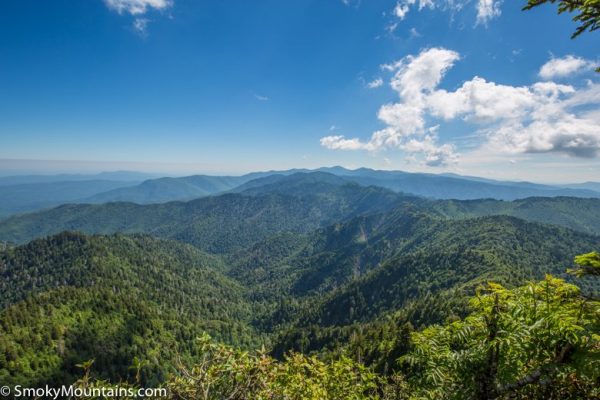
North America’s National Parks, forests and wilderness areas are popular tourist destinations for tens-of-millions of visitors each year. For many, these trips are simply an opportunity to get closer to nature — but an unlucky few find themselves stuck after straying away from the trail, enduring poor weather conditions, or becoming injured.
To understand more about how hikers survived such dangerous situations and made it out alive, SmokyMountains.com analyzed over 100 news reports to discover how survivors got lost in the first place; if and how they found warmth, shelter, food, and water; whether they stayed put or kept moving; and whether they found their own way out or were rescued.
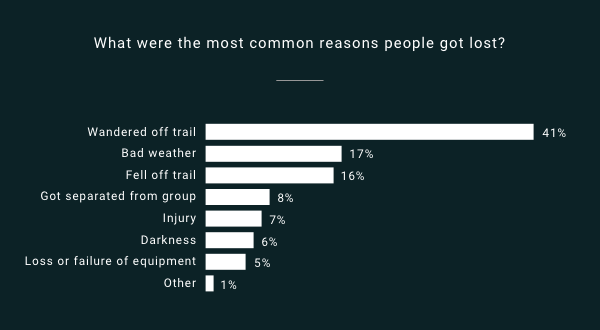
The most common way that hikers got lost was by wandering off the trail (41%). In 17% of cases, bad weather was to blame, while 16% of news reports analyzed cited falling off the trail as the cause.
The full list of reasons cited for hikers getting lost are below:
| Reason for getting lost | % that got lost this way |
| Wandered off trail | 41% |
| Bad weather | 17% |
| Fell off trail | 16% |
| Got separated from a group | 8% |
| Injury | 7% |
| Darkness | 6% |
| Loss or failure of equipment | 5% |
| Other | 1% |

In order to stay warm, 12% relied on clothes, while 10% built fires and a further 10% used camping gear. Other methods of keeping warm that were named included the body heat of fellow hikers (including dogs), hikers covering themselves, exercise and digging in.
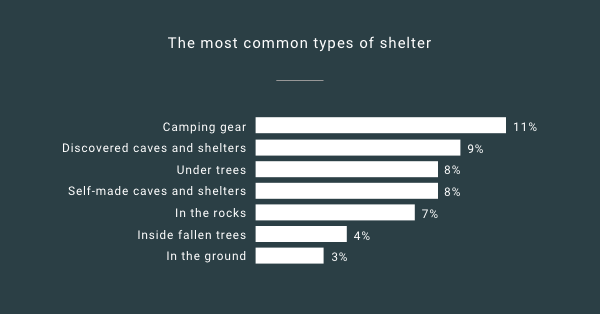
For shelter, 11% of survivors used camping gear. Some 9% were able to discover caves and other existing shelters, while 8% took shelter beneath trees. A selection of other shelters was named, such as self-made caves and shelters, and taking shelter in rocks, inside fallen trees, and in the ground.
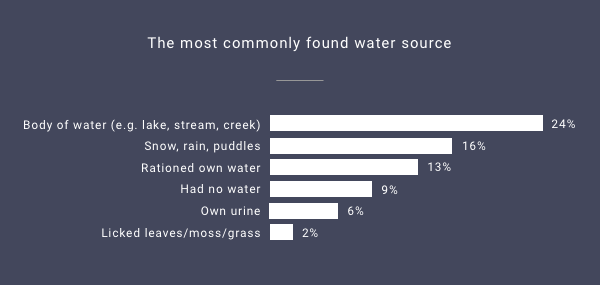
In order to stay hydrated, survivors needed a reliable source of water. Almost a quarter found a natural body of water (24%), 16% used snow, rain or puddles and 13% rationed their own water (13%). Other sources of water that were named included drinking urine, going without water or licking leaves, moss and grass for hydration.
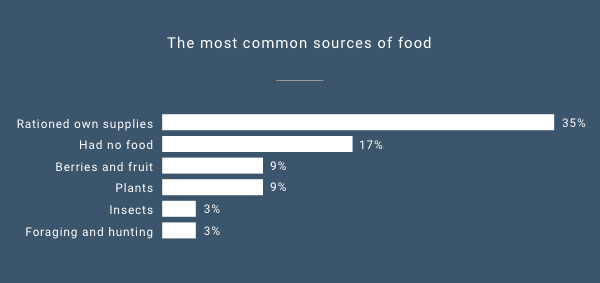
Survivors also needed to find food. Over a third were able to ration their own supplies (35%), 17% went without food entirely, and 9% ate berries and fruit. A number of hikers also ate plants and insects, while others foraged and hunted for food.
To find a way back to safety, survivors were faced with an important decision: whether they should stay put and wait to be rescued, or if they should keep moving in order to find their own way out. The research found that two-thirds decided to keep moving (65%), while just a third chose to stay put (35%).

And when it came to making it out, just under a quarter found a way out themselves (23%) and the remaining 77% were rescued.
Andrew Herrington, a survival instructor, search and rescue team leader, and Wildlife Ranger in the Smokies, shared his top hiking advice with SmokyMountains.com:
How to prepare for a hike or backpacking trip
- Carry the Ten Essentials
- Leave a trip plan and check-in time with two trusted people
- Study your maps and identify a “bailout” direction in the area you’re exploring
- Check the weather forecast (including an overnight in case you’re forced to stay out)
- Always use high-quality clothing: Merino or synthetic base layers, mid layers, synthetic or dry-down puffy jackets, and Gore-Tex shells
- Practice lightweight tarp shelter building at home
- Print off free maps at sartopo.com
- Download a backup GPS app, like Avenza
- Practice fire making and carry the gear (including petroleum jelly-soaked cotton balls and fatwood sticks)
- Look into Personal Locator Beacons and Satellite Messengers for cutting edge signaling options
Avoid getting lost
- Identify features on the ground and find them on the map as you go
- If you’re off-trail, work out how to reach a linear trail, road or creek
- If you’re unsure of your location, start breaking branches in the direction you’re traveling, or skin a 6-inch cut on a sapling with your knife. The inner bark shows white and is easy to follow
Stay warm
- Avoid sweating into your clothes in cold weather
- Stay cool when you’re active and warm at rest
- Monitor for hypothermia signals in the group
- Warm up with sugary foods, exercise, or a big fire
Shelter
- Use your tarp, puffy jacket and quilt to create a warm cozy shelter
- Keep a 55-gallon trash bag in your pocket in case you’re separated from your pack
- If you have no other option, build a lean-to shelter (framework of sticks, covered with leaf litter, evergreen branches, or bark – whichever is most available) and heat it with a 6-foot-long fire
- Build a bed out of leaves, grass, or pine needles, at least 8 inches thick
Water
- Use a lightweight filter, Chlorine dioxide tablets, or a steel canteen to boil and purify water
- In the worst-case scenario, just drink the water – statistically, in the US, you will be rescued within 24 hours – death from dehydration is a bigger risk than infection
Food
- Pack high-calorie foods like almond butter and coconut oil packs
- If you have no food, don’t try to hunt, trap, or forage – it just exposes you to potential injury
- Instead, fast: the average person has over 30 days of calories to survive on
- Prioritize building a camp, staying warm, and hydrated
Move or stay put?
- If you left a trip plan and someone knows you are missing, or if you’re stranded in a vehicle or on a trail, old road, or creek – stay where you are
- Consider “self-rescue” if you didn’t tell anybody where you were going, and have no way to signal
- Navigate to an open area, high ground for cell signal, or your “bailout” direction, leaving a trail as you go
Getting rescued
- Use brightly colored tarps and clothing
- Call 911 on your cell phone, even if you don’t have service. By law, any tower that you can connect with will transmit that call
- Use signal mirrors or three blasts on your whistle to attract attention
- Add green plants to your fire to create a smoke signal
- Movement and contrast are key to being seen if you hear a rescue plane or helicopter
SmokyMountains.com also ran a survey to find out how many Americans know how to perform a series of different survival skills. The figures revealed some worrying results:
- Just 33% of respondents know how to use a compass
- 24% are confident they’d be able to build a makeshift shelter in the wild
- 19% know how to use a signal fire, flares or a flare gun
- Just 17% believe they could start a fire without a lighter or matches
- 16% are confident they could forage for food in the wild
- And a further 16% believe they could find safe drinking water in the wilderness
- And 52% said they couldn’t complete a single of these tasks

Methodology:
103 survival stories were sourced from online newspaper reports about hikers who went missing and were subsequently found or rescued from national parks, wilderness areas, and forests across the US and Canada. Data was collected between 15th-17th December 2018.
- Percentages shown reflect the share of stories, where the information on how the survivors found warmth, shelter, food, and water was disclosed.
- In cases where percentages don’t add up to 100%, the remaining share of stories didn’t mention the relevant details.
- Where entries contained multiple options, totals were grouped together.
- For “Rescued vs Found way out”, the latter captures all cases where the lost hiker(s) found people, flagged down trucks, or physically reached civilization in one way or another. This doesn’t mean there was no rescue operation underway.
- For “Kept moving vs Stayed put”, in some cases people did both. Data reflects what the survivor spent the most time doing.
- For “Food” and “Water”, percentages refer to cases where tactics were mentioned. “Had no water” or “Had no food” captures cases where it was stated that the person had no water or food for all/most of the time they were lost.

